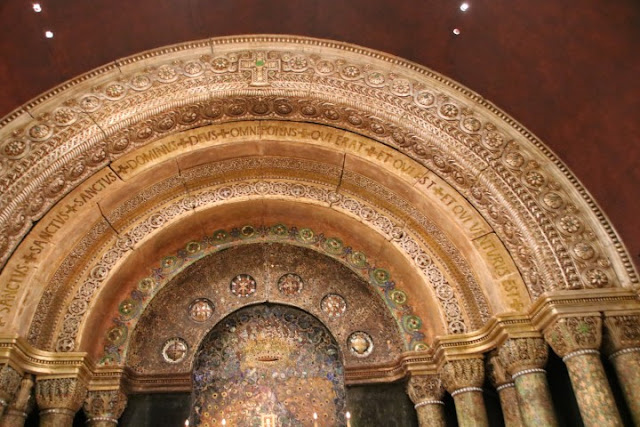Sally and Beth host inSPIREd Sunday! Sundays in my City My Sunday Photo
December 2016 - Orlando FL
We visited the Morse Museum on Friday and saw the incredible Tiffany Chapel.
As I headed in John was coming out and said he figured I'd be in there for hours. He was almost right! He finished the rest of the museum before I came out.
I was just mesmerized!!
In 1893 Louis Comfort Tiffany exhibited a chapel interior at the World’s Columbian Exposition in Chicago that brought him international acclaim few American artists enjoyed at the time. It was installed in the Tiffany & Co. (the jewelry firm founded by his father) pavilion in the Manufactures and Liberal Arts Building.
It included six ornately carved plaster arches, 16 mosaic columns, a 1,000-pound, 10-by-8-foot electrified chandelier, or “electrolier,’’ in the shape of a cross, a marble and white glass mosaic altar, a dome-shaped baptismal font, and several windows.
In 1898, a wealthy woman—Mrs. Celia Whipple Wallace—bought the chapel for the Cathedral Church of St. John the Divine under construction at the time in New York City. Never placed as it was intended, the chapel was relegated to a basement crypt where its arches were cut to fit under a low, broadly vaulted ceiling. For more than 10 years (1899–1911) it functioned as a chapel at St. John the Divine and then was closed when the choir above was completed for services.
Unchecked water damage took its toll on the architecture and decoration of the chapel, and in 1916 Louis Comfort Tiffany wrote to the church of his concern that “the mosaic work has suffered” and offered to remove it at his expense.
Click here for our first visit to St. John the Divine.
For decades, many of the chapel elements had remained in packing crates as the McKeans researched the locations of the various chapel furnishings that had been dispersed after 1949. They systematically acquired these furnishings as they became available to keep all of the chapel parts in a single collection.
In 1996, the Board of Trustees of the Charles Hosmer Morse Foundation endorsed an expansion project for the Morse Museum that would fulfill the dream of the McKeans to reassemble Tiffany’s 1893 chapel.




















...a work of art.
ReplyDeleteBeautiful windows, they can be so hard to capture well. Happy New Year. #MySundayPhoto
ReplyDeleteTruly beautiful.
ReplyDeleteI really love the pillars & arches behind the altar. They are beautiful
ReplyDelete